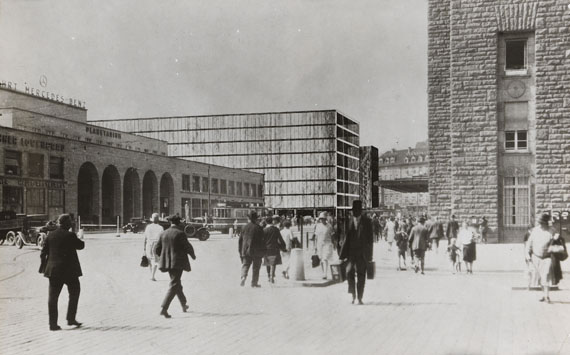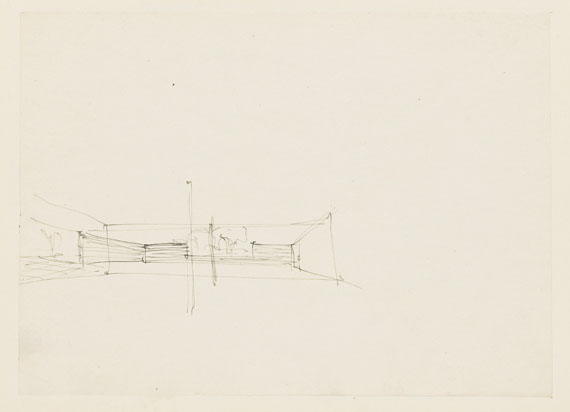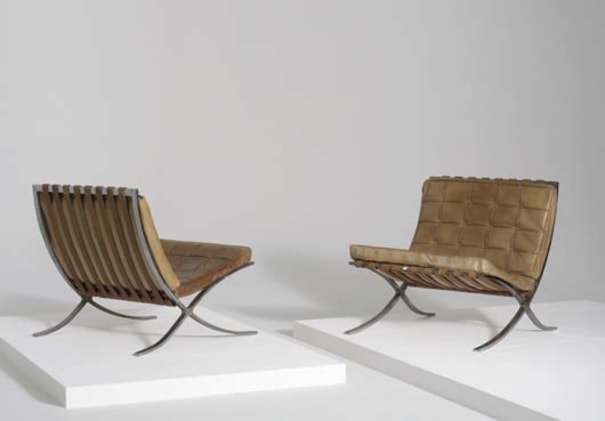Ludwig Mies van der Rohe Rare ‘Tugendhat’ coffee table, model no. MR 150/3, produced by Bamberg circa 1929-31 Chrome-plated steel, opaque glass, stained plywood. 48 x 99.7 x 99.7 cm (18 7/8 x 39 1/4 x 39 1/4 in) Underside with embossed manufacturer’s metal label ‘BAMBERG METALLWERKSTÄTTEN/BERLIN NEUKOLLN • LICHTENRADER STRASSE 32/D.R.P. und Auslandspatente’ and Farben Fabrik inventory metal label with ‘FARBENFABRIK/WOLFEN/Inv.-Nr.: 67817’. Underside of table and each detachable pylon impressed with ‘1’, ‘2’, ‘3’ and ‘4’ respectively.
Provenance I. G. Farben, Farbenfabrik, Wolfen, Germany Private collection, Switzerland, circa 1931 Private collection, Switzerland, 1972 Acquired from the above, 2008 Exhibited ‘The Essence of Things: Design and the Art of Reduction’, Vitra Design Museum, Weil am Rhein, 20 March–19 September 2010 then travelled to: Museum August Kestner Hannover (9 March–2 June 2011), Design Museum, Gent (8 July–16 October 2011) Literature Alexander Von Vegesack and Matthias Kries, eds., Mies van der Rohe: Architecture and Design in Stuttgart, Barcelona, Brno, exh. cat., Vitra Design Museum, Weil am Rhein, 1998, for an excerpt from a Bamberg Metallwerkstätten brochure dated 1931 on p. 34, and for a technical drawing dated 1931 on p. 108 fig. 19.1 Helmut Reuter and Birgit Schulte, eds., Mies and Modern Living: Interiors, Furniture, Photography, Ostfildern, 2008, p. 160 fig. 163 for an excerpt from a Bamberg Metallwerkstätten brochure dated 1931 Alexander Von Vegesack and Mathias Schartz-Clauss, eds., The Essence of Things: Design and the Art of Reduction, Weil am Rhein, 2010, illustrated on p. 99 fig. 128 Catalogue Essay The present table bears a Bamberg Metallwerkstätten manufacturer’s label affixed to the painted plywood support on the underside of its black glass top. This model appears as MR 150/3 in the 1931 Bamberg Metallwerkstätten sales catalogue. At the time the company was located at Lichtenrader Strasse 32, Berlin. The present lot is the only known example of MR 150/3. The model number denotes the table’s black glass top – Schwarzglasplatte – as opposed to the palisander top of the related MR 150/1 and the clear glass of the MR 150/2. The MR 150/3 is further distinguished by the four pylons which support its top. The palisander and clear glass tops of the other models rested directly on their metal bases. All variations were available with flat steel bases produced in one of three treatments: painted, nickel-plated, or chrome-plated. At a price of 600 Reichsmarks (as printed in the sales catalogue), the present chrome-plated table would have been the most expensive of the MR 150 variations. In addition to its manufacturer’s label, the present table bears an inventory label (fig. 4) from the IG Farben factory in Wolfen, then located about 20 kilometres to the south of the Bauhaus in Dessau, where Mies van der Rohe was director from 1930–33, concurrent with production of the present lot. A German chemical industry conglomerate, IG Farben was among the world’s largest companies at the time. In addition to his renowned German Pavilion at the 1929 Exposicion Internacional in Barcelona, Mies also designed the IG Farben presentation (fig. 1) at the 1929 Exposicion. In that pavilion IG Farben exhibited screens of sample black glass (fig. 2) similar to that produced in the present table. In their recent catalogue accompanying ‘The Essence of Things’, a 2010 exhibition at the Vitra Design Museum where the present lot appeared, editors Alexander von Vegesack and Mathias Schartz-Clauss wrote: “This unique version of the coffee table also realized for the Villa Tugendhat in Brno was probably designed for the IG Farben presentation at the 1929 World’s Fair in Barcelona.” Lots 95, 96, and 97 were acquired in by the present owner from private Swiss collectors who resided in a house designed circa 1929 by Luise ‘Lux’ Guyer (1894–1955), a prominent Swiss architect active in Zurich and among the first women architects to open her own practice in that country. Those previous owners had in turn purchased the house and its contents, including the present three lots, in 1972 from the original occupants of the house. Read More
Ludwig Mies van der Rohe Rare ‘Tugendhat’ coffee table, model no. MR 150/3, produced by Bamberg circa 1929-31 Chrome-plated steel, opaque glass, stained plywood. 48 x 99.7 x 99.7 cm (18 7/8 x 39 1/4 x 39 1/4 in) Underside with embossed manufacturer’s metal label ‘BAMBERG METALLWERKSTÄTTEN/BERLIN NEUKOLLN • LICHTENRADER STRASSE 32/D.R.P. und Auslandspatente’ and Farben Fabrik inventory metal label with ‘FARBENFABRIK/WOLFEN/Inv.-Nr.: 67817’. Underside of table and each detachable pylon impressed with ‘1’, ‘2’, ‘3’ and ‘4’ respectively.
Provenance I. G. Farben, Farbenfabrik, Wolfen, Germany Private collection, Switzerland, circa 1931 Private collection, Switzerland, 1972 Acquired from the above, 2008 Exhibited ‘The Essence of Things: Design and the Art of Reduction’, Vitra Design Museum, Weil am Rhein, 20 March–19 September 2010 then travelled to: Museum August Kestner Hannover (9 March–2 June 2011), Design Museum, Gent (8 July–16 October 2011) Literature Alexander Von Vegesack and Matthias Kries, eds., Mies van der Rohe: Architecture and Design in Stuttgart, Barcelona, Brno, exh. cat., Vitra Design Museum, Weil am Rhein, 1998, for an excerpt from a Bamberg Metallwerkstätten brochure dated 1931 on p. 34, and for a technical drawing dated 1931 on p. 108 fig. 19.1 Helmut Reuter and Birgit Schulte, eds., Mies and Modern Living: Interiors, Furniture, Photography, Ostfildern, 2008, p. 160 fig. 163 for an excerpt from a Bamberg Metallwerkstätten brochure dated 1931 Alexander Von Vegesack and Mathias Schartz-Clauss, eds., The Essence of Things: Design and the Art of Reduction, Weil am Rhein, 2010, illustrated on p. 99 fig. 128 Catalogue Essay The present table bears a Bamberg Metallwerkstätten manufacturer’s label affixed to the painted plywood support on the underside of its black glass top. This model appears as MR 150/3 in the 1931 Bamberg Metallwerkstätten sales catalogue. At the time the company was located at Lichtenrader Strasse 32, Berlin. The present lot is the only known example of MR 150/3. The model number denotes the table’s black glass top – Schwarzglasplatte – as opposed to the palisander top of the related MR 150/1 and the clear glass of the MR 150/2. The MR 150/3 is further distinguished by the four pylons which support its top. The palisander and clear glass tops of the other models rested directly on their metal bases. All variations were available with flat steel bases produced in one of three treatments: painted, nickel-plated, or chrome-plated. At a price of 600 Reichsmarks (as printed in the sales catalogue), the present chrome-plated table would have been the most expensive of the MR 150 variations. In addition to its manufacturer’s label, the present table bears an inventory label (fig. 4) from the IG Farben factory in Wolfen, then located about 20 kilometres to the south of the Bauhaus in Dessau, where Mies van der Rohe was director from 1930–33, concurrent with production of the present lot. A German chemical industry conglomerate, IG Farben was among the world’s largest companies at the time. In addition to his renowned German Pavilion at the 1929 Exposicion Internacional in Barcelona, Mies also designed the IG Farben presentation (fig. 1) at the 1929 Exposicion. In that pavilion IG Farben exhibited screens of sample black glass (fig. 2) similar to that produced in the present table. In their recent catalogue accompanying ‘The Essence of Things’, a 2010 exhibition at the Vitra Design Museum where the present lot appeared, editors Alexander von Vegesack and Mathias Schartz-Clauss wrote: “This unique version of the coffee table also realized for the Villa Tugendhat in Brno was probably designed for the IG Farben presentation at the 1929 World’s Fair in Barcelona.” Lots 95, 96, and 97 were acquired in by the present owner from private Swiss collectors who resided in a house designed circa 1929 by Luise ‘Lux’ Guyer (1894–1955), a prominent Swiss architect active in Zurich and among the first women architects to open her own practice in that country. Those previous owners had in turn purchased the house and its contents, including the present three lots, in 1972 from the original occupants of the house. Read More











Try LotSearch and its premium features for 7 days - without any costs!
Be notified automatically about new items in upcoming auctions.
Create an alert